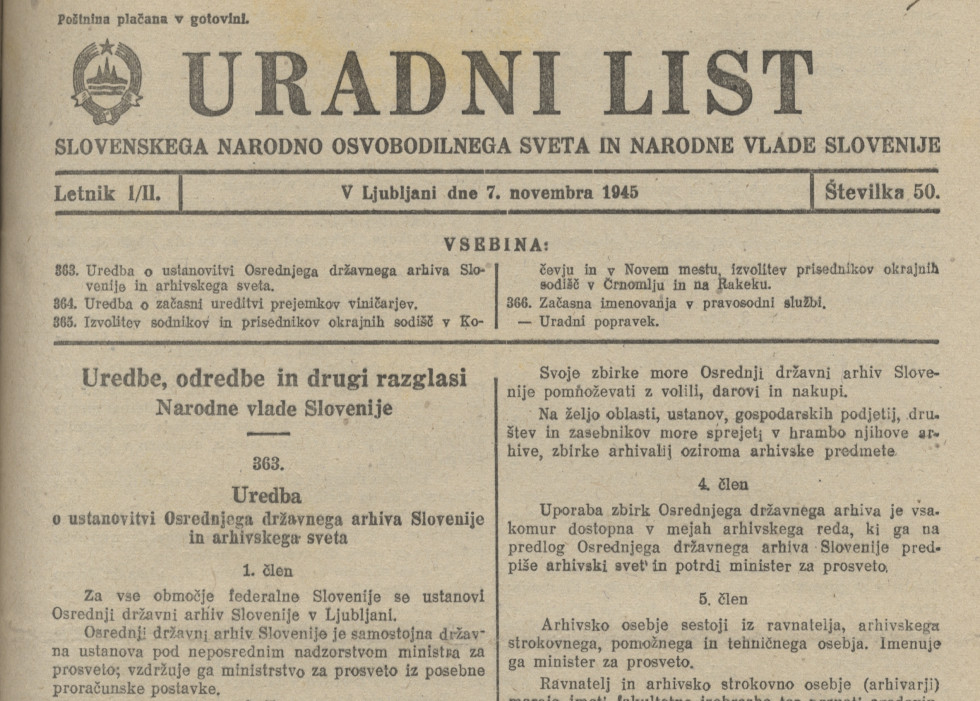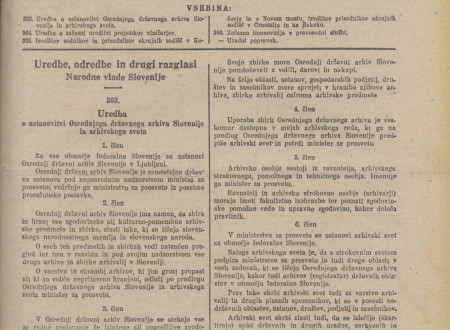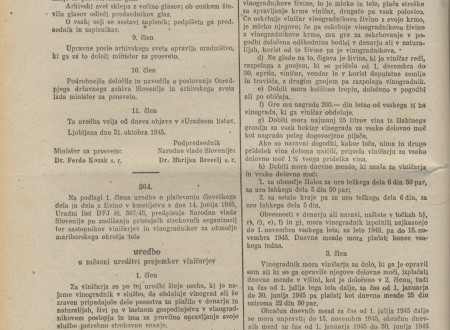75 years of the Archives of the Republic of Slovenia as an independent institution
Our path to an independent institution
The Central State Archives of Slovenia and Archival Council were established on October 31, 1945 based on the decree issued by the Slovenian National Government (Official Gazette of the Slovenian National Liberation Council and the National Government of Slovenia, 1944-1945, 50/1945). Coming into force when published in the Official Gazette on November 7, 1945, the decree among other provisions determined that the Central State Archives of Slovenia be established for “the entire territory of the federal Slovenia”. The newly-founded Archives thus became an independent state institution under direct supervision of the Ministry of Culture (Article 1).
“The purpose of the Central State Archives is to collect and preserve all historically and culturally significant archival objects and collections, especially those concerning Slovenian ethnic territory and Slovenian nation. The Archives keeps a complete record of all its archival holdings and collections and it registers and supervises all other Slovenian archival institutions and holdings.” (Article 2)
“The Central State Archives of Slovenia gathers and preserves all non-current historically and scientifically important archival records created by Slovenian state authorities and institutions. All of the components and the entire inventory of the State Archive of the National Museum in Ljubljana are hereby transferred to the Central State Archives of Slovenia. Placed in its custody are also archival collections and holdings owned or administered by the state …” (Article 3)
“Users may access archival holdings of the Central State Archives, if so permitted by archival rules …” (Article 4)
“The head of the Archives and archivists employed must have university education and be well familiar with auxiliary sciences of history and with administrative history, as determined by the rules.” (Article 5)
From the National Museum to Gruber Palace
The Archives of the Republic of Slovenia is these days celebrating the 75th anniversary of its founding. When established in 1945, it was in charge of the public archival records from all over the Slovenian territory, since at the time there were no other regional archives operating, apart from the Ljubljana City Archives (present day Historical Archives of Ljubljana). Regional archives were established later on, mainly during the 1950s, but in the absence of proper regulations, any sort of active archival network had yet to be set up.
The newly created Central State Archives “inherited” the holdings of the State Archives, kept in the repositories of the National Museum of Slovenia. It also began to collect records created by pre-war institutions and state offices that had ceased to operate. It supervised the storage, arranging and disposing of records by local people’s committees, courts and business organizations. In their effort to save valuable archival records as quickly and as efficiently as possible, the Archives often turned to seek help from some of the highest ranking government officials, but often to no avail. Swept by the revolutionary social changes, some clerks tended to disregard certain archival material created by the former offices, storing it either in their attics or in damp basements, often even using it as wrapping paper, or just simply taking it to paper mills to be recycled.
Lack of suitable work and storage space was a major problem at first, especially in the years before 1953, when the newly created Archives had still been operating under the roof of the National Museum of Slovenia. They had at their disposal only one office measuring 26 m² for administrative and archival work and three repositories of total 217 m². Since this obviously was not enough, some of the archival records had to be stored also in the attic of the National and University Library in Ljubljana and in the basements of several public and privately owned buildings in Ljubljana.
Despite all the obstacles, users were allowed access to archival documents from as early as May 1946. From 1955 on, a register of the transferred archival records was being compiled and archivists also began collecting data on archival documents that had been taken away during the occupation. In 1954, a special in-house library was set up at the Archives as well.
At the end of 1953, the Archives was given a space of 683 m² on the first floor of Gruber Palace and in Virant’s House in Levstik Square. In 1965, it was finally given permission to occupy and manage the entire building complex between Levstik Square and Zvezdarska and Rožna Street. The newly allocated premises were spacious enough to store almost all of our archival holdings, which up to then had been scattered on different locations in Ljubljana. Even today, Gruber Palace in Zvezdarska Street 1 continues be the seat of the Archives of the Republic of Slovenia. Apart from this central building, the Archives of RS also occupies repository in Roška Street and is renting additional office space in Zemljemerska Street in Ljubljana.
Due to administrative and political changes in Slovenia, the Central State Archives often changed its name; in 1953 it was renamed into the State Archives of the People’s Republic of Slovenia, in 1963 into the State Archives of the Socialist Republic of Slovenia, in 1966 into the Archives of Slovenia, and in 1975 into the Archives of the Socialist Republic of Slovenia. Since June 1990, its official name has been the Archives of the Republic of Slovenia.
Slovenia’s long tradition of caring for archival records
If truth be told, the Archives of the Republic of Slovenia would also be justified to celebrate even some more important anniversaries. Namely, Slovenians have a long tradition of systematic care for our archival material – a practice which from as early as the first half of the 19th century was developing in Carniola in much the same manner as in other Austro-Hungarian lands. Charters and valuable manuscripts in particular were from very early on collected and described by a number of Slovenian institutions, societies and even individuals. In 1859, the Historical Society of Carniola suggested that Carniolan authorities establish their own provincial archive, but this idea was never put into practice. When the Carniolan Provincial Museum ”Rudolfinum” moved into its own building in 1888, some of its room was allocated to the Carniolan Provincial Archives, which at the time was operating as a constituent part of the Carniolan Provincial Museum.
Although the first Yugoslav state officially founded its State Archives in 1926, the newly created institution still continued to operate only as an organizational unit of the National Museum, with its activities limited mostly to the territory of the former land of Carniola. There were also continuous challenges of having to face lack of suitable space and archival personnel. At first archival work was carried out by the Head of the National Museum Josip Mal himself, who only in 1939 was given the permission to employ a person to work solely as an archivist.
Although calls for the establishment of a central public archival institution, which would care for archival records from all Slovenian regions, started as early as at the beginning of the 20th century and intensified after 1918, the First and Second World War in many ways slowed down any organizational and personnel changes that in different circumstances might have led to the formation of an independent archival institution.
This pioneer era, when the Archives was still operating as part of the Carniolan Provincial Museum (later National Museum of Slovenia), has yet to be thoroughly researched. Perhaps the celebration of the bicentenary of the Carniolan Provincial Museum (1821) - the common predecessor of all major cultural heritage institution in Slovenia (National Museum of Slovenia, Archives of the Republic of Slovenia, National Gallery, Slovenian Ethnographic Museum, Slovenian Museum of Natural History) - will also be an opportunity for further research of the early history of systematic care for Slovenian archival records prior the foundation of the Central State Archives. This would finally shed some additional light on the history of the institution which today has 8 organizational units (divisions), employs 68 people (5 of them work part time on EU project), and preserves 28,000 running metres of archival material, arranged into more than 1930 archival fonds and collections.
Andrej Nared




